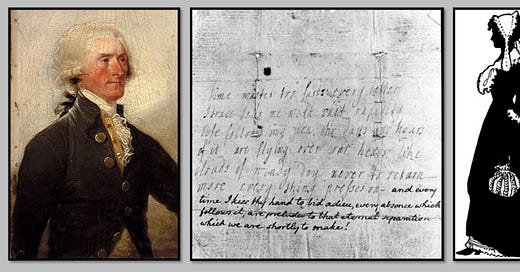On this day in 1748, Martha Wayles, future wife of Thomas Jefferson, is born.
Martha “Patty” Wayles Skelton Jefferson is a bit of a mystery! We don’t even have a portrait of her, although the attached silhouette is believed to be hers. Jefferson burned all of their correspondence after her death. By all accounts, though, the two were deeply in love.
Patty was a young and wealthy widow when the two married on New Year’s Day in 1772. Their first child was born 8 months and 26 days after their wedding. They named her Martha, and they called her “Patsy.” Mrs. Jefferson would have six total children over the course of her ten year marriage to Jefferson. Only two would live to adulthood.
Patty had difficult pregnancies that were hard on her health. In fact, during the Revolutionary War years, Jefferson often chose to serve in ways that kept him close to home in Virginia. He wanted to be nearby. Unfortunately, Patty’s last pregnancy seems to have been the final straw. She died when her youngest daughter Lucy was only four months old. An overseer at Monticello described the scene when Patty passed away:
“Mr. Jefferson sat by her, and she gave him directions about a good many things that she wanted done. When she came to the children, she wept, and could not speak for some time. . . . [S]he told him she could not die happy if she thought her four children were ever to have a stepmother brought in over them . . . . Mr. Jefferson promised her solemnly that he would never marry again.”
The promise is not as crazy as it might seem. Jefferson would have known of Patty’s difficult experiences with her own two stepmothers. Some historians have questioned the account because it incorrectly states that Patty had four living children at a time when she had three living children. But other aspects of the account check out, and the overseer may have just misremembered that one detail.
At some point before her death, Patty and Jefferson recited a favorite love verse together. The verse was copied with the first half in her handwriting and the second half in his. (See photo.) It is the only known piece of writing still existing between the two. It reads:
“Time wastes too fast: every letter I trace tells me with what rapidity life follows my pen. The days and hours of it are flying over our heads like clouds of windy day never to return—more. every thing presses on—and every time I kiss thy hand to bid adieu, every absence which follows it, are preludes to that eternal separation which we are shortly to make!”
Patty passed away on September 6, 1782. Jefferson was inconsolable. His daughter later said that he was led to the library “almost in a state of insensibility.” He locked himself in his room, sobbing and pacing for three long weeks. Sometimes, he went on horseback rides. “[I]n those melancholy rambles,” his daughter wrote, “I was his constant companion, a solitary witness to many a violent burst of grief.”
It took a while, but Jefferson finally pulled himself out of his despondent state, at least in part because of his children. In 1785, he finally accepted a mission to serve America in France. He’d turned down these types of requests before, but now he went.
Obviously, Jefferson had other relationships later in his life, including controversial ones with Sally Hemings and Maria Cosway. Nevertheless, the young widower never tried to remarry at a time when remarriage was common and (almost) expected.
Was he simply keeping a promise that he’d made to the love of his life? We may never know.
Sources can always be found on my website, here.





Looking through the lens of the past, we tend to think of our ancestors as emotionally cold and well acquainted with death. Scenes like this help us to see that they were as passionate, sensitive and emotional as we are.
Thank you Tara. I can imagine how deeply the Jeffersons loved each other and how difficult the death of Martha must have been for Thomas Jefferson. His despair must have been nearly unbearable and I would think that he failed to remarry due to the wishes of his wife. A remarkable man and a human response to the death of his spouse.